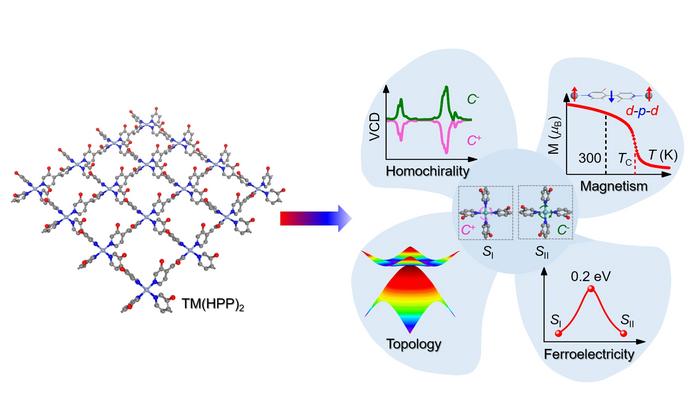In a groundbreaking development in the field of materials science, a team of researchers has unveiled a novel class of homochiral organometallic nanosheets. This innovative material exhibits remarkable properties, specifically room-temperature multiferroicity and distinct topological characteristics. The research, spearheaded by Associate Professor Li Xiangyang and Professor Wang Xianlong from the Institute of Solid State Physics at the Hefei Institutes of Physical Science under the Chinese Academy of Sciences, along with Professor Li Xingxing from the University of Science and Technology of China, presents a significant leap in the quest for multifunctional materials suitable for next-generation electronic devices.
The findings, which were recently published in the prestigious journal Nano Letters, address a pivotal issue facing next-generation electronic information technologies: the limited functionality of current multiferroic and magnetic topological materials due to their typically low Curie temperatures. These materials, essential for advanced applications in electronics, often exhibit magnetic order only at significantly low temperatures, thereby hampering their usability in real-world conditions. The study tackles these limitations head-on, exploring the intersection of chirality with multiferroic and topological properties in a way that has not been thoroughly investigated until now.
Multiferroicity and topological phenomena are crucial for developing technologies capable of ultrafast data processing and storage. These properties allow materials to exhibit multiple ferroic orders—such as ferromagnetism and ferroelectricity—coupled with topologically protected states, which is an area of intense research. The significance of achieving room-temperature functionality in these materials cannot be overstated, as it opens the door to practical applications in ambient conditions, vastly enhancing their potential usability.
In this research, the team has introduced a unique method for constructing these nanosheets, leveraging 4-(3-hydroxypyridin-4-yl)pyridin-3-ol (HPP) as an organic linker and utilizing transition metals like chromium (Cr), molybdenum (Mo), and tungsten (W) as the central nodes. The resulting materials, denoted as TM(HPP)2, demonstrate not only room-temperature multiferroicity but also intricate topological features. The homochirality arises from the inherent chiral nature of the HPP organic linkers, which plays a crucial role in the materials’ functionality.
Chirality is a fascinating aspect of modern materials science, particularly in the context of enhancing the functionalities of multiferroic materials. Generally associated with molecular recognition and chiral sensing, chirality introduces a level of complexity that can potentially enhance the performance of electronic devices. The research team’s approach successfully integrates chirality into the design of these organometallic nanosheets, setting the stage for new innovations in the field.
A pivotal element of this research is the discovery of Weyl phonon topological phase transitions, which occur as a result of structural variations in chirality. The room-temperature magnetic properties observed in these materials are attributed to strong direct spin coupling between the transition metal cations and the HPP doublet anions. This coupling mechanism is essential for achieving the desired magnetism and is a significant factor in the materials’ overall functionality and application potential.
The team has identified that the ferroelectric properties of these new nanosheets are a direct result of breaking spatial inversion symmetry. This phenomenon paves the way for advanced manipulation of light absorption and phonon topology by employing an external electric field. Such capabilities allow for unprecedented control over the material’s properties, thus broadening the horizon for applications where customizable optical and magnetic features are critical.
Among the revolutionary advancements highlighted in this research, the most striking is the elevation of the Curie temperature of multiferroic materials to ambient conditions. This achievement not only categorically enhances the practicality of these materials but also promises to stimulate fresh directions in materials research. Such developments could lead to exciting discoveries across various scientific and engineering domains, fortifying the understanding of integrated chirality, magnetism, ferroelectricity, and topological phenomena.
Moreover, the combination of different materials at the nanoscale provides opportunities for exploring previously unidentified physical phenomena. The team’s work exemplifies how interdisciplinary approaches, marrying chemistry, physics, and materials science, can yield novel insights and transformative technologies. This holistic perspective is essential as researchers continue to seek materials that can fulfill the complex demands of modern electronics.
Notably, the implications of this research are broad-reaching, inviting engagement from various scientific fields. Researchers interested in chirality, topological materials, and multifunctional devices will find this study particularly compelling, as it proposes a fresh perspective on how to integrate complex features into single materials. The potential applications of these findings could stretch across various sectors, including data storage, information processing, and advanced sensing technologies.
The advent of these chiral organometallic nanosheets marks an exciting development in the ongoing quest for materials that not only meet technical specifications but also enhance current technological paradigms. What this research ultimately underscores is the importance of advancing our understanding of the intricate relationships between structure and functionality in materials, especially as we persist in our efforts to drive forward the boundaries of technology into the realm of the extraordinary.
The results of this pioneering investigation have not only laid a foundation for future research but also carved pathways into new scientific territories that merge disciplines and unite theoretical understanding with practical application. As researchers examine the nuances of this work, the anticipation grows for the broader implications it may hold for the future of electronic materials and devices. The essence of this research encapsulates the excitement of discovery, showcasing the perpetual journey of science in dismantling the barriers of knowledge and translating it into real-world applications.
Subject of Research: Homochiral Organometallic Nanosheets
Article Title: Designing Chiral Organometallic Nanosheets with Room-Temperature Multiferroicity and Topological Nodes
News Publication Date: 14-Jan-2025
Web References:
References:
Image Credits: Credit: ZHAO Jing
Keywords
Physical sciences, materials science, multiferroicity, chirality, topological materials, organometallic nanosheets, electronic devices.
Tags: advanced applications in electronicschiral organometallic nanosheetschirality in materials researchInstitute of Solid State Physics研究low Curie temperature challengesmagnetic topological materialsmultifunctional materials for electronicsnext-generation electronic devicesroom-temperature multiferroicitysignificant advancements in material propertiestopological properties in materials scienceultrafast data processing technologies





